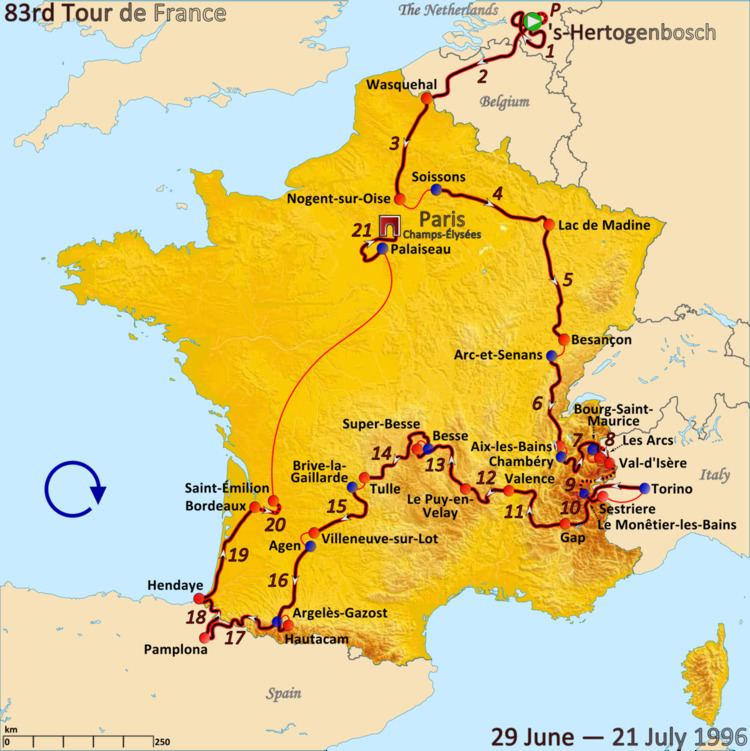Dates 29 June – 21 July Distance 3,765 km (2,339 mi) Winner Bjarne Riis (DEN) | Stages 21 + Prologue Winning time 95h 57' 16" Second Jan Ullrich (GER) | |
 | ||
The 1996 Tour de France was the 83rd edition of the Tour de France, starting on 29 June and ending on 21 July, featuring 19 regular stages, 2 individual time trials, a prologue and a rest day (10 July). It was won by Danish rider Bjarne Riis.
Contents
This Tour was noted by the "fall" of favorite Miguel Indurain, ending his record run of five consecutive victories. The course included a stage through his home town Villava, however he suffered a bronchitis because of the poor weather in the first week, and was fined and penalised for accepting drinks illegally. Indurain started to lose time in stage 7, and finally ended 11th failing to win a single stage or spend one day in the yellow jersey.
Stage 9 was scheduled to be a 176 kilometer ride from Val-d'Isère to Sestriere. However, due to appalling weather conditions, including snow, the organizers cut the stage to just 46 km. Bjarne Riis won the stage and opened a crucial 44 second gap over Telekom teammate Jan Ullrich. Ullrich, only 22, really broke through in this Tour, and won the individual time trial of stage 20.
Over a decade after the race, several riders with Team Telekom confessed to doping offences around the period of the 1996 tour, including support riders Rolf Aldag, Udo Bölts, Christian Henn and Brian Holm and team masseur Jef d'Hont has admitted in his autobiography that there was organised use of EPO in the team. On 24 May 2007, Erik Zabel admitted to using EPO during the first week of the race. The winner of the Tour, Bjarne Riis, admitted on 25 May 2007 that he also used EPO during the Tour, as a result was asked by the International Cyling Union (UCI) to return the yellow jersey he received. So far, runner-up Jan Ullrich, who has been under suspicion of doping as a part of the Operación Puerto doping case, has not commented on allegations that he also used EPO. Third place Richard Virenque and fourth place Laurent Dufaux were implicated in the 1998 Festina scandal.
UCI lawyer Philippe Verbiest stated in 2007 that the statute of limitations for removing Riis as winner of the Tour de France had expired, "you cannot strip him of the title but it possible not to mention it anymore ... Because of what he admitted, he is not the winner of the Tour de France. Riis did not win." At the same time tour spokesman Philippe Sudres stated that: "We consider philosophically that he can no longer claim to have won.". In 2007, Riis' victory was removed from the Tour de France, yet in 2008 they listed Riis as winner of Tour de France 1996, albeit with a remark about his confession.
Teams
The 18 teams on top of the UCI rankings at the start of 1996 automatically qualified for the Tour. Four wildcards were given, for a total of 22 teams
The teams entering the race were:
Qualified teams
Invited teams
Classification leadership
There were several classifications in the 1996 Tour de France. The most important was the general classification, calculated by adding each cyclist's finishing times on each stage. The cyclist with the least accumulated time was the race leader, identified by the yellow jersey; the winner of this classification is considered the winner of the Tour.
Additionally, there was a points classification, which awarded a green jersey. In the points classification, cyclists got points for finishing among the best in a stage finish, or in intermediate sprints. The cyclist with the most points lead the classification, and was identified with a green jersey.
There was also a mountains classification. The organisation had categorized some climbs as either hors catégorie, first, second, third, or fourth-category; points for this classification were won by the first cyclists that reached the top of these climbs first, with more points available for the higher-categorized climbs. The cyclist with the most points lead the classification, and was identified with a polkadot jersey.
The fourth individual classification was the young rider classification, which was not marked by a jersey. This was decided the same way as the general classification, but only riders under 26 years were eligible.
For the team classification, the times of the best three cyclists per team on each stage were added; the leading team was the team with the lowest total time.
For the combativity award classification, a jury gave points after each stage to the cyclists they considered most combative. The cyclist with the most votes in all stages lead the classification.
